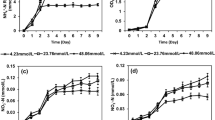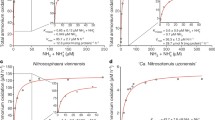Abstract
Ammonia oxidation, as measured by nitrite production, was inhibited by 2-chloro-6-trichloromethyl-pyridine (nitrapyrin, N-serve) in the methane-oxidizing bacterium,Methylosinus trichosporium OB3b, and the autotrophic nitrifying organisms,Nitrosococcus oceanus andNitrosomonas marina. 6-Chloropicolinic acid, a hydrolysis product of nitrapyrin, was ineffective as an inhibitor of ammonia oxidation by either the methanotroph or the autotrophs. Picolinic acid (2-carboxy-pyridine), in contrast, inhibited nitrification by the methane-oxidizing bacterium but not by the autotrophic cultures. Picolinic acid may provide a means for differentiating ammonia oxidation attributable to methanotrophs from that resulting from autotrophs in environmental studies.
Similar content being viewed by others
Literature Cited
Belser, L. W., Schmidt, E. L. 1981. Inhibitory effect of nitrapyrin on three genera of ammonia-oxidizing nitrifiers. Applied and Environmental Microbiology41:819–821.
Billen, G. 1976. Evaluation of nitrifying activity in sediments by dark14C-bicarbonate incorporation. Water Research10:51–57.
Bremner, J. M., Blackmer, A. M., Bundy, L. G. 1978. Problems in use of nitrapyrin (N-serve) to inhibit nitrification in soil. Soil Biology and Biochemistry10:441–442.
Campbell, N. E. R., Aleem, M. I. H. 1965. The effect of 2-chloro-6-(trichloromethyl) pyridine on the chemoautotrophic metabolism of nitrifying bacteria. Antonie van Leeuwenhoek Journal Microbiology and Serology31:124–136.
Dalton, H. 1977. Ammonia oxidation by the methane-oxidizing bacteriumMethylococcus capsulatus strain Bath. Archives of Microbiology114:273–279.
Focht, D. D., Verstraete, W. 1977. Biochemical ecology of nitrification and denitrification. Advances in Microbial Ecology1:135–214.
Gasser, J. K. R. 1970. Nitrification inhibitors—their occurrence, production, and effects on their use on crop yields and composition. Soil and Fertilizers33:547–554.
Goring, C. A. I. 1962. Control of nitrification by 2-chloro-6-(trichloromethyl) pyridine. Soil Science93:211–218.
Harrits, S. M., Hanson, R. S. 1980. Stratification of aerobic methane-oxidizing organisms in Lake Mendota, Madison, Wisconsin. Limnology and Oceanography25:412–421.
Henriksen, K. 1980. Measurement of in situ rates of nitrification in sediment. Microbial Ecology6:329–337.
Higgins, I. J., Quayle, J. R. 1970. Oxygenation of methane by methane-grownPseudomonas methanica andMethanomonas methanooxidans. Biochemical Journal118:201–208.
Higgins, I. J., Hammond, R. C., Sariaslani, F. S., Best, D., Davies, M. M., Tryhorn, S. E., Taylor, F. 1979. Biotransformation of hydrocarbons and related compounds by whole organism suspensions of methane-grownMethylosinus trichosporium OB3b. Biochemical and Biophysical Research Communications89:671–677.
Higgins, I. J., Best, D. J., Hammond, R. C. 1980. New findings in methane utilizing bacteria highlight their importance in the biosphere and their commercial potential. Nature286:561–564.
Hollocher, T. C., Tate, M. E., Nicholas, D. J. D. 1981. Oxidation of ammonia byNitrosomonas europaea: definitive18O-tracer evidence that hydroxylamine formation involves a monooxygenase. Journal of Biological Chemistry256:10834–10836.
Hutton, W. E., Zobell, C. E. 1953. Production of nitrite from ammonia by methane-oxidizing bacteria in sediments. Journal of Bacteriology65:216–219.
Hyder, S. L., Meyers, A., Cayer, M. L. 1979. Membrane modulation in a methylotrophic bacteriumMethylococcus capsulatus (Texas) as a function of growth substrate. Tissue and Cell11:597–610.
Hyman, M. R., Wood, P. M. 1983. Methane oxidation byNitrosomonas europaea. Biochemical Journal212:31–37.
Lowry, O. H., Rosebrough, N. J., Farr, A. L., Randall, R. J. 1951. Protein measurement with the Folin phenol reagent. Journal of Biological Chemistry193:265–275.
Malashenko, Y. R., Sokolov, I. G., Romanovskaya, V. A., Shkurko, Y. B. 1979. Elements of lithotrophic metabolism in the obligate methylotrophMethylococcus thermophilus. Microbiologiya48:592–598.
O'Neill, J. R., Wilkinson, J. F. 1977. Oxidation of ammonia by methane-oxidizing bacteria and the effects of ammonia on methane oxidation. Journal of General Microbiology100:407–412.
Redemann, C. T., Meikle, R. W., Widofsky, J. G. 1964. Nutrient conserving agents: loss of 2-chloro-6-(trichloromethyl) pyridine from soil. Journal of Agriculture and Food Chemistry12:207–218.
Ribbons, D. W., Michalover, J. L. 1970. Methane oxidation by cell-free extracts ofMethylococcus capsulatus. Federation of European Biochemical Societies Letters11:41–44.
Rudd, J. W. M., Taylor, C. D. 1980. Methane cycling in aquatic environments. Advances in Aquatic Microbiology2:77–150.
Salvas, P. L., Taylor, B. F. 1980. Blockage of methanogenesis in marine sediments by the nitrification inhibitor 2-chloro-6-(trichloromethyl) pyridine (nitrapyrin or N-serve). Current Microbiology4:305–308.
Shattuck, G. E., Alexander, M. 1963. A differential inhibitor of nitrifying microorganisms. Proceeding of the Soil Society of America27:600–601.
Somville, M. 1978. A method for the measurement of nitrification rates in water. Water Research12:843–848.
Strickland, J. D. H., Parsons, T. R. 1972. A practical handbook of seawater analysis. Bulletin of the Fisheries Research Board of Canada, Volume 167.
Suzuki, I., Dular, U., Kwok, S. C. 1974. Ammonia or ammonium ion as substrate for oxidation byNitrosomonas europaea cells and extracts. Journal of Bacteriology120:556–558.
Tate, III, R. L. 1977. Nitrification in histosols: a potential role for the heterotrophic nitrifier. Applied and Environmental Microbiology33:911–914.
Watson, S. W., Valois, F. W., Waterbury, J. B. 1981. The family Nitrobacteriaceae, pp. 1005–1022. In: Starr, M. P., Stolp, H., Truper, H. G., Balows, A., Schlegel, H. G., (eds.), The prokaryotes, vol. 1. New York: Springer-Verlag.
Whittenbury, R., Dalton, H., Eccleston, M., Reed, H. L. 1975. The different types of methane oxidizing bacteria and some of their more unusual properties, pp. 1–9. In: Terui, G., (ed.), Microbial growth on C1 compounds. Proceedings of the International Symposium on Microbial Growth on C1 Compounds, Tokyo. Osaka: Society of Fermentation Technology.
Author information
Authors and Affiliations
Rights and permissions
About this article
Cite this article
Salvas, P.L., Taylor, B.F. Effect of pyridine compounds on ammonia oxidation by autotrophic nitrifying bacteria andMethylosinus trichosporium OB3b. Current Microbiology 10, 53–56 (1984). https://doi.org/10.1007/BF01576048
Issue Date:
DOI: https://doi.org/10.1007/BF01576048




